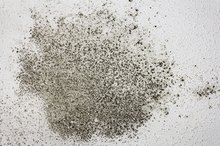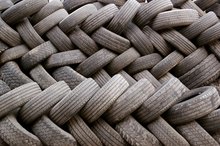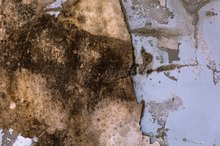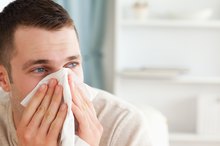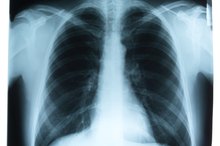Health Problems Caused by Mold
Molds have several deleterious effects on human health. Pathogenic (disease-causing) molds gain access to the body in several ways, including through the foods we eat, through broken skin and the air we breathe. Molds also emit poisons, called mycotoxins, which can cause a variety of health problems ranging from sinus inflammation and headaches to more serious disease states such as cancer.
If you are experiencing serious medical symptoms, seek emergency treatment immediately.
Respiratory illnesses
Most respiratory illnesses are caused by inhalation of mold spores in a flooded or moldy environment known as a “sick building,” on construction sites or on a farm. Sometimes more insidious illness can occur from inhaling mold spores. Farmer’s Lung is caused by mold spores that grow in hay, stored grain or silos. The attack usually occurs five to six hours after the exposure. Symptoms include fever, malaise, shortness of breath and pain or tightness in the chest. Chronic conditions of Farmer’s Lung include chest colds. Without prompt treatment, permanent damage can be done to the lungs.
- Most respiratory illnesses are caused by inhalation of mold spores in a flooded or moldy environment known as a “sick building,” on construction sites or on a farm.
- Without prompt treatment, permanent damage can be done to the lungs.
Gastrointestinal Problems
Diseases Linked to Black Mold
Learn More
Gastrointestinal problems are most often a result of eating food contaminated with molds. This is not limited to visible mold. Rather, mold toxins called mycotoxins commonly contaminate certain foods and are invisible to the naked eye. More than 400 different types of mycotoxins exist. Cornell University reports, “Corn is probably the commodity of greatest worldwide concern, because it is grown in climates that are likely to have perennial contamination with aflatoxins (a mycotoxin) and corn is the staple food of many countries.” Mycotoxins are not limited to corn 2. They are also found in grains, peanuts and alcohol. Mycotoxins can cause gastrointestinal problems including vomiting, diarrhea and bleeding. Chronic mold exposure can also lead to candidiasis, or yeast infections, in the stomach.
- Gastrointestinal problems are most often a result of eating food contaminated with molds.
- Rather, mold toxins called mycotoxins commonly contaminate certain foods and are invisible to the naked eye.
Birth Defects
As mentioned previously, corn is universally contaminated with mold poisons. Corn contains the mycotoxin fumonisin b1. Increased fumonisin b1 intake in corn products, such as corn tortillas, has been linked to neural tube birth defects. Interestingly, taking folic acid decreases the effects of this toxin. The journal Teratology reported in 2002 that “Fumonisin has the potential to inhibit neural tube defects. Folic acid can reverse some of these effects.”
- As mentioned previously, corn is universally contaminated with mold poisons.
- The journal Teratology reported in 2002 that “Fumonisin has the potential to inhibit neural tube defects.
Neurotoxicity
Side Effects of Mold Inhalation
Learn More
Mold exposure has also been linked to neurological conditions in humans. Symptoms can range from muscle spasms and hyperirritability to blindness and stupor. Ergot is a mycotoxin found in breads and emitted by indoor molds such as Stachybatrys chartarum. The journal Clinical Microbiology Reviews reported in 2003: “Neurologic or convulsive ergotism is characterized by symptoms including muscle spasms, seizures, and hallucinations, often from compounds produced during the baking of bread using contaminated grain.” This neurotoxic phenomenon is not a new concept. In the 1960s and 1970s, many people consumed “magic” mushrooms for their hallucinogenic effects.
- Mold exposure has also been linked to neurological conditions in humans.
- The journal Clinical Microbiology Reviews reported in 2003: “Neurologic or convulsive ergotism is characterized by symptoms including muscle spasms, seizures, and hallucinations, often from compounds produced during the baking of bread using contaminated grain.”
Cancer
Mold and mycotoxin exposure is a risk for development of certain cancers. The Colorado Department of Agriculture says, “Aflatoxin is the most potent, naturally occurring carcinogen known to man. Besides ergot, the Stachybotrys mycotoxins include aflatoxin, trichotecenes and zearalenone. The journal Clinical Microbiology Reviews reported in 2003: “Penicillium species produce patulin and penicillic acid can cause tumors …. Zearalenone, is among the most widely distributed of the fusarial mycotoxins and is found in 6 to 28 percent of corn samples destined for human consumption. Significant concerns have been raised as a result of its estrogenic activity and thus its potential for stimulating estrogen-sensitive tumors.” The best way to avoid exposure to mold and mold toxins is to avoid foods that contain the toxins, and to clean moldy environments as soon as possible while wearing a mask to limit inhalation of spores.
- Mold and mycotoxin exposure is a risk for development of certain cancers.
- The journal Clinical Microbiology Reviews reported in 2003: “Penicillium species produce patulin and penicillic acid can cause tumors ….
Related Articles
References
- Journal of the American Medical Association: Mycotoxins
- Cornell University: Aflatoxins
- Amirhosein Ghaffarianhoseini, Husam AlWaer, Hossein Omrany, Ali Ghaffarianhoseini, Chaham Alalouch, Derek Clements-Croome & John Tookey (2018) Sick building syndrome: are we doing enough?. Architectural Science Review,61:3, 99-121.
- American College of Allergy, Asthma & Immunology. Mold Allergy. Reviewed April 23, 2018.
- Centers for Disease Control and Prevention. Fungal Diseases. Reviewed May 6, 2019.
- Centers for Disease Control and Prevention. Mold. Basic Facts. Reviewed December 20, 2017
- Asthma and Allergy Foundation of America. Mold Allergy. Reviewed October 2015.
- Centers for Disease Control and Prevention. Molds in the Environment. Rreviewed December 20, 2017.
- Asthma and Allergy Foundation of America, Mold Allergy
- Centers for Disease Control and Prevention (CDC), Mold, Basic Facts
- Rudert A, Portnoy J.Mold allergy: is it real and what do we do about it?Expert Rev Clin Immunol. 2017 Aug;13(8):823-835. doi: 10.1080/1744666X.2017.1324298. Epub 2017 May 17.
Writer Bio
Jami Cooley is a registered nurse who was first published in 2005. She is the co-author of "Eating Your Way to Good Health" and "The Fungs Link Volume 3." She also founded Nutritional Nursing Specialists. Cooley is certified in chemotherapy and biotherapy from M.D. Anderson hospital of Houston.
